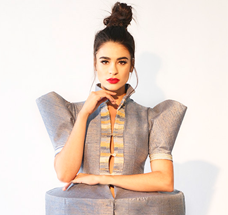A pattern is an outline made on hard paper depending upon each individual’s style to wear garments. It is the template from where a garment’s parts are traced to the fabric before being cut or assembled. This step is one of the most important steps in garment making. Pattern making for womenswear is a highly skilled technique that needs methodological skills, knowledge about design, and practical understanding of garment preparation. Pattern making acts as a bridge between your design and production of a dress.
A basic pattern is made by two different methods- drafting or draping fabric over a model. Pattern drafting is a drawing pattern on brown paper with accurate precision depending on body measurements and or standard measuring chart. It is an economical method used for making various patterns or styles of dresses.
Types of Paper Patterns Available-
Various types of paper patterns are found to help a designer draft the design for an outfit on a paper. If you are new to this business and want to start your boutique or garments store, you can avail online pattern-making courses or buy CDs that will help you to have a vivid knowledge of garment designing, drafting, and pattern making.
- Standardised Paper Pattern– the paper pattern is made by using body measurements. This method is practiced during training and tailoring courses.
- Individual Paper Pattern- Here, the measurement of an individual is taken into account, and a pattern is made on that particular measurement. A pattern made for one person will not suit another person. These patterns are mainly made for customised orders or at specialised tailoring shops.
- Final Paper Pattern- once the individual is satisfied with standardised paper pattern, the final paper pattern is made. While making individual paper patterns, several precautions are maintained; some minor changes or issues that are left behind, are corrected while making final paper patterns.
- Block Paper Patterns– these patterns are made with standard sizes on cardboard. These patterns are mainly used in the larger garment manufacturing industries. Apparels made out of these block patterns will normally fit everyone with similar body type as they have standard measurements.
- Graded Paper Pattern– patterns of 5 common sizes like 30″, 32″, 34″, 36″ and 38″ chest sizes are made with one single pattern. The required size as per individual body measurement is taken separately, cut, and used.
- Readymade Paper Pattern– in this type of pattern making, a unique tracing paper is used. These tracing papers are brought from the market and are best suitable for people in the stitching business. These patterns are available in readymade sizes and used easily by putting the pattern on the fabric, cutting the shape, and stitched.
- Commercial Paper Pattern– These patterns are available in various colours and designs. These patterns are available in an envelope with a design instruction sheet. The sheet will give you an idea of selecting the right fabric, marking the fabric, cutting, and sewing steps.
Benefits of Using Paper Patterns
- A perfect pattern that has a size sheet made on individual requirements results in a better fit.
- Paper pattern made on thick cardboard is highly durable and can be reused several times
- By using the flat pattern method, anyone can make patterns to get original designs
- Paper pattern of a particular size is suitable to make patterns of other sizes by the grading process
- These patterns can be customised or modified as per the latest fashion trends.
This is a basic guide on pattern making for designing apparels. If you want to have some ideas on designing and drafting women’s dresses, you can learn from online courses provided by Patterns Creations.



